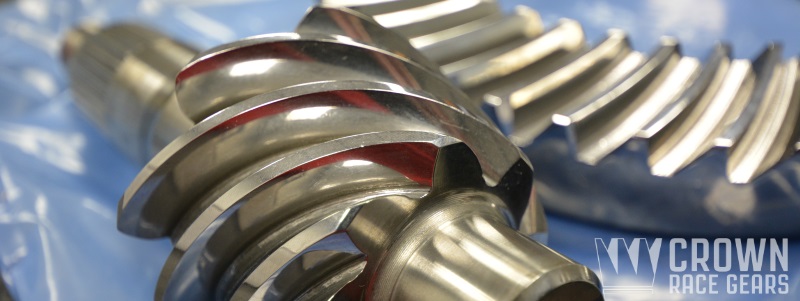- sales@racegears.com
- 720-545-2274
Crown Race Gears / Process Overview
Ring and Pinion Gear Production Process

Crown Race Gears produces the strongest, toughest, most efficient, and longest-lasting racing ring and pinion gears in the industry. The entire process, from sourcing the ideal steel alloy to the final quality control inspection is extremely complex, and every step is focused specifically on producing the best racing gears possible. Below is a simplified outline of the steps involved in the creation of our racing gears and each process is further described and analyzed in the sections that follow as you move through this report.

1. Metallurgy - The production process begins by selecting a steel alloy with specific characteristics that allow it to be machined, heat treated, and surface finished to achieve the desired gear properties.
2. Forging - Gear blanks are formed by heating the steel in a furnace to 2,000°F before placing it into a set of progressive dies where thousands of tons of force are applied to press it into the desired shape.
3. Normalizing - To relieve internal stresses caused by the tremendous forces applied during the forging process, the gear blanks are heated to 1,700°F and then left to air cool back to room temperature.
4. Lathe Machining - Prior to cutting the gear teeth, gear blanks are turned on a lathe to bring them to perfect roundness and to establish a pilot bore so they can be precisely mounted in a CNC machine.
5. Soft CNC Gear Cutting - The ring and pinion gear teeth are cut on a Gleason 275HC Bevel Gear Cutting Machine following highly precise gear geometry engineered to maximize strength and power transfer efficiency.
6. Case Hardening - Increasing surface hardness is achieved by heating the gear in a carbon-rich environment and then cooling it rapidly to lock the exterior atomic structure into a new, harder arrangement.
7. Hard CNC Gear Finishing - Finalizing the gear geometry and removing any distortions caused by case hardening is done again on the Gleason 275HC Bevel Gear Cutting Machine in a hard finishing process.
8. Primary Shot Peening - To remove surface tensions and bury imperfections for significantly improved gear life, the ring and pinion gears are bombarded with thousands of tiny ball bearings at high velocity.
9. Lapping - Mating ring and pinion gears together is done on another CNC machine that turns the gears against each other within an abrasive slurry that wears away any microscopic interferences.
10. Cryogenic Treatment - Freezing the gears to -315°F for an extended period of time completes the case hardening process and significantly improves the core microstructure for improved toughness.
11. Secondary Shot Peening - A second round of shot peening is performed to target the gear tooth roots where the highest dynamic forces are seen, to further improve durability and fatigue resistance.
12. REM ISF Finishing - A non-abrasive, chemical-mechanical process used in aerospace and Formula 1 racing is performed to significantly reduce friction and operating temperatures to improve efficiency
13. Magnaflux - Finished ring and pinion gears destined for racing applications are inspected for micro fractures using a chemical liquid or magnetic powder under UV lighting (this is an optional process).
14. Quality Control - Quality is observed and documented throughout the entire manufacturing process with continual adjustments made to ensure all gears meet our strict specifications and tolerances.
15. Gear Marking - After passing quality control, each ring and pinion pair is assigned a serial number that is etched into the outside diameter of the gears along with the gear specifications and C.R.G. logo.
16. Packaging - Finished gears are then cleaned up and sleeved in anti-corrosion bags before being placed in a custom formed hard case along with the inspection sheet and C.R.G. literature.
